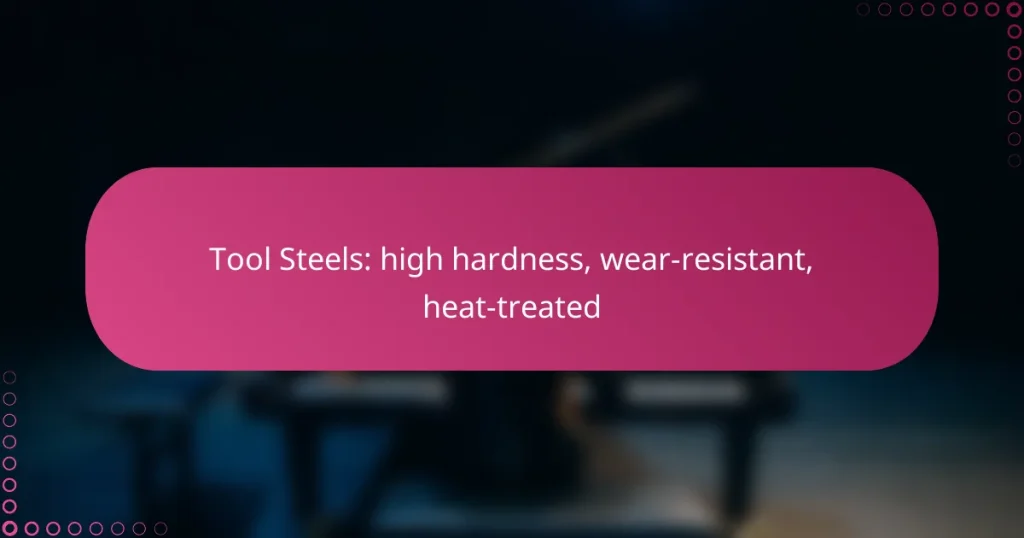Tool steels are engineered for high hardness, exceptional wear resistance, and effective heat treatability, making them essential for manufacturing cutting tools and dies. Notable grades such as D2, A2, and M2 exhibit unique properties tailored to various applications, ensuring they maintain their edge under demanding conditions. The heat treatment process further enhances their performance by increasing hardness and durability, allowing them to withstand significant stress while retaining their shape.

What are the best tool steels for high hardness?
The best tool steels for high hardness include D2, A2, and M2, each offering unique properties suited for different applications. These steels are designed to withstand wear and maintain their edge, making them ideal for cutting tools and dies.
D2 Tool Steel
D2 tool steel is a high-carbon, high-chromium steel known for its excellent wear resistance and ability to hold a sharp edge. It typically achieves a hardness range of 55-62 HRC after heat treatment, making it suitable for applications like dies, punches, and shear blades.
When working with D2, consider its susceptibility to chipping if not properly heat treated. It is often used in cold work applications due to its toughness and ability to withstand high stress.
A2 Tool Steel
A2 tool steel is an air-hardening steel that offers a good balance of toughness and wear resistance, achieving hardness levels of 57-62 HRC. It is versatile and can be used for various applications, including tooling, dies, and blades.
One advantage of A2 is its resistance to deformation during heat treatment, which makes it easier to work with compared to other tool steels. However, it may not perform as well in extreme wear situations compared to D2.
M2 Tool Steel
M2 tool steel is a high-speed steel that combines high hardness with excellent wear resistance, often reaching hardness levels of 62-65 HRC. It is particularly effective for cutting tools that require high performance at elevated temperatures.
Due to its composition, M2 is ideal for applications like drill bits, milling cutters, and saw blades. However, it is more expensive than other tool steels, so it is essential to evaluate cost versus performance for specific projects.

How do heat-treated tool steels improve wear resistance?
Heat-treated tool steels enhance wear resistance primarily by increasing their hardness and durability. This process involves heating the steel to a high temperature and then cooling it rapidly, which alters its microstructure and significantly improves its performance in demanding applications.
Increased hardness
Heat treatment processes, such as quenching and tempering, elevate the hardness of tool steels, making them less prone to deformation and wear. Hardness is typically measured on the Rockwell scale, with heat-treated tool steels often achieving values in the high 50s to low 60s HRC (Rockwell Hardness Scale).
For practical applications, this increased hardness allows tool steels to maintain sharp edges and resist abrasion during cutting or machining tasks. Selecting the right heat treatment process is crucial, as different alloys respond uniquely to these treatments, impacting their final hardness.
Enhanced durability
Durability in heat-treated tool steels is a result of their improved resistance to wear and fatigue. This enhancement means that tools made from these steels can withstand repeated use without significant degradation, which is essential in industrial settings.
For example, a properly heat-treated tool steel can last several times longer than untreated steel in high-stress applications. When selecting tool steels, consider the specific heat treatment process and the intended application to ensure optimal durability and performance in your projects.

What are the key properties of tool steels?
Tool steels are characterized by their high hardness, wear resistance, and heat treatability, making them ideal for manufacturing tools and dies. These properties enable tool steels to withstand significant stress and maintain their shape during use.
High hardness
High hardness is a fundamental property of tool steels, allowing them to retain sharp edges and resist deformation under load. Typically, tool steels achieve hardness levels ranging from 50 to 70 HRC (Rockwell Hardness Scale) after proper heat treatment.
To attain high hardness, tool steels often contain alloying elements such as carbon, chromium, and vanadium. The specific composition and heat treatment process can significantly affect the final hardness, so selecting the right type of tool steel for the intended application is crucial.
Wear resistance
Wear resistance refers to the ability of tool steels to withstand abrasion and erosion during use. This property is essential for tools that encounter friction and contact with other materials, as it prolongs their lifespan and reduces the frequency of replacements.
Tool steels with high wear resistance often incorporate elements like tungsten and molybdenum, which enhance their durability. For example, D2 tool steel is known for its excellent wear resistance, making it suitable for cutting tools and dies.
Heat treatability
Heat treatability is the capacity of tool steels to undergo heat treatment processes to improve their mechanical properties. This process typically involves heating the steel to a specific temperature, followed by quenching and tempering to achieve the desired hardness and toughness.
When selecting tool steels, consider their heat treatability to ensure optimal performance. Some grades, like A2 and O1, are known for their ease of heat treatment, while others may require more precise control during the process to achieve the best results.

Which industries use tool steels?
Tool steels are essential in various industries due to their high hardness, wear resistance, and ability to withstand heat treatment. These properties make them ideal for manufacturing tools and components that require durability and precision.
Aerospace
The aerospace industry relies on tool steels for manufacturing components that must endure extreme conditions. Parts such as turbine blades and landing gear require materials that can withstand high temperatures and stress, making tool steels a preferred choice.
Common tool steels used in aerospace applications include A2 and D2, which offer excellent toughness and wear resistance. These steels are often subjected to rigorous testing to meet strict safety and performance standards.
Automotive
In the automotive sector, tool steels are crucial for producing tools and dies used in the fabrication of vehicle parts. Their ability to maintain hardness at elevated temperatures is vital for processes like stamping and molding.
High-speed steels, such as M2, are frequently used for cutting tools in automotive manufacturing. These steels provide the necessary hardness and wear resistance to handle the demands of high-volume production.
Manufacturing
Manufacturing industries utilize tool steels for a wide range of applications, including cutting tools, molds, and dies. The versatility of tool steels allows manufacturers to select specific grades tailored to their operational needs.
For example, S7 tool steel is often chosen for applications requiring shock resistance, while O1 is favored for its ease of machining. Understanding the specific requirements of each manufacturing process is key to selecting the appropriate tool steel grade.

What factors should be considered when selecting tool steels?
When selecting tool steels, consider factors such as application requirements, heat treatment methods, and the specific properties needed for performance. Each of these elements plays a crucial role in ensuring the tool steel meets the demands of its intended use.
Application requirements
Application requirements dictate the type of tool steel needed based on the specific tasks it will perform. For instance, tools used for cutting may require high hardness and wear resistance, while those used for forming might prioritize toughness and ductility.
Evaluate the operational environment, including temperature, pressure, and the materials being processed. For example, high-speed machining applications often benefit from tool steels like M2 or M4, which maintain hardness at elevated temperatures.
Heat treatment methods
Heat treatment methods significantly influence the final properties of tool steels. Common techniques include quenching, tempering, and annealing, each affecting hardness, toughness, and wear resistance differently. For instance, quenching can increase hardness but may also introduce brittleness if not tempered properly.
Consider the specific heat treatment process that aligns with the tool’s intended use. A typical approach might involve heating the steel to a specific temperature, followed by rapid cooling to lock in hardness, and then tempering to reduce brittleness. Understanding these methods helps in achieving the desired balance of properties for optimal performance.

How do tool steels compare to other materials?
Tool steels are specifically designed for high hardness and wear resistance, making them superior for cutting and shaping applications compared to many other materials. Their performance is often enhanced through heat treatment, which increases their durability and longevity in demanding environments.
Tool steel vs. stainless steel
Tool steel and stainless steel serve different purposes, with tool steel primarily used for manufacturing tools, dies, and molds due to its hardness and wear resistance. In contrast, stainless steel is favored for its corrosion resistance and aesthetic appeal, making it ideal for kitchenware and medical instruments.
When comparing the two, tool steels typically have a higher hardness rating, often exceeding 60 HRC, while stainless steels generally range from 30 to 50 HRC. This hardness makes tool steels better suited for applications requiring high durability, but they may be more susceptible to corrosion without proper treatment.
Tool steel vs. high-speed steel
High-speed steel (HSS) is a subset of tool steels specifically designed for high-speed machining applications. HSS maintains its hardness at elevated temperatures, which allows for faster cutting speeds compared to standard tool steels.
While both materials are used in cutting tools, HSS is often preferred for drill bits and milling cutters due to its ability to withstand heat generated during high-speed operations. Tool steels, on the other hand, are typically used for applications where extreme hardness and wear resistance are critical, such as in dies and punches.


